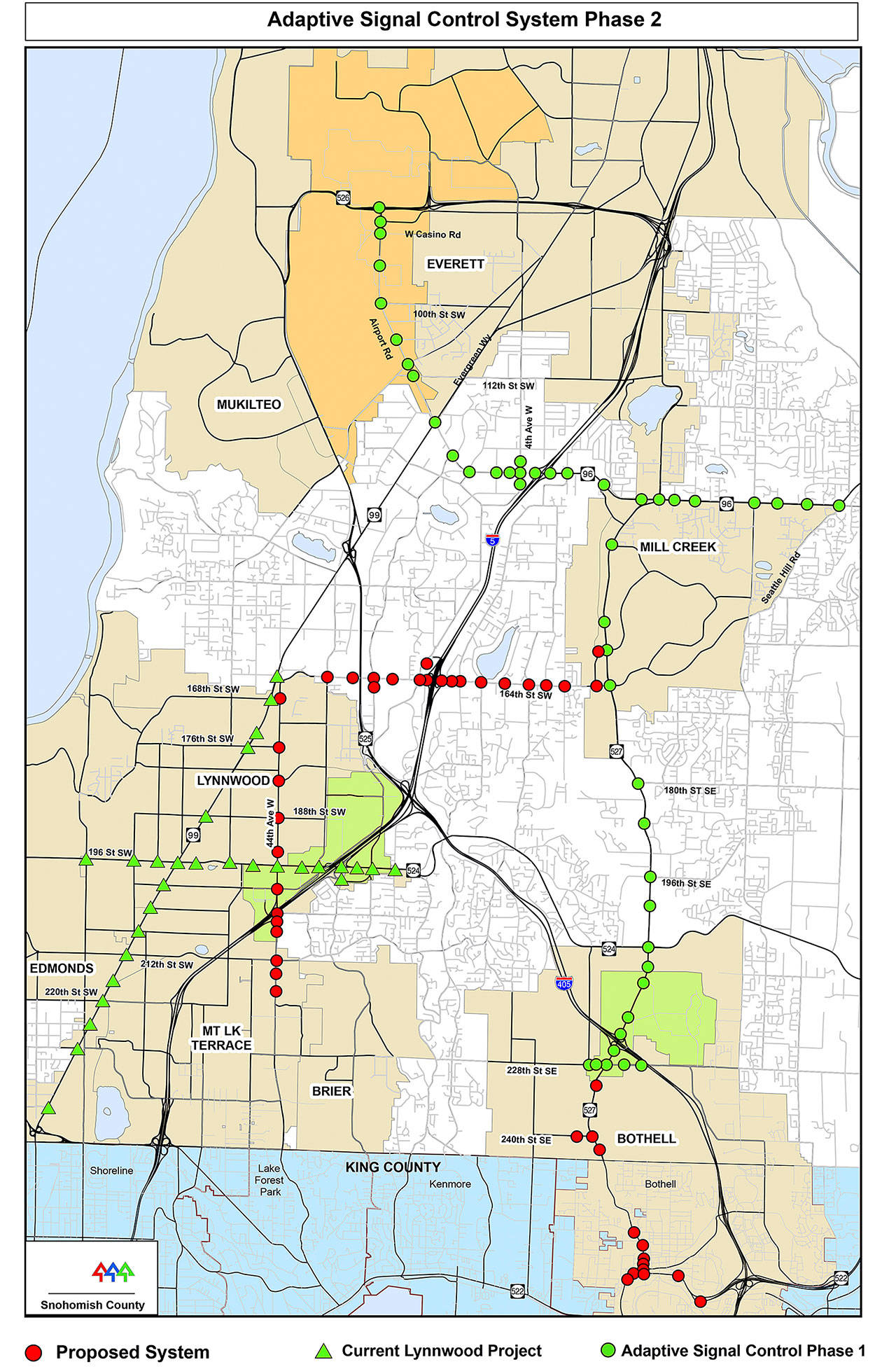LYNNWOOD — Nothing but green. Now isn’t that every driver’s dream?
An increased chance of it is coming to major corridors in the south end.
Snohomish County is leading an adaptive traffic signal control system that will help traffic signals better communicate with each other, letting each signal anticipate the traffic that’s coming, add in variables like pedestrians or a bus, and plan accordingly.
“It’s almost like putting a traffic engineer on every corner,” said Paul Coffelt, traffic engineer for Lynnwood, one of the project’s partners.
Other partners are the Washington State Department of Transportation and the cities of Bothell, Everett, Mill Creek and Mountlake Terrace.
The system initially will connect the manufacturing and industrial center at Boeing and Paine Field to the Canyon Park regional center in Bothell. It will involve upgrades at 47 traffic signals, on Highway 527 from 228th Street SE to Highway 96, and on Highway 96 (also known as 128th Street SW and Airport Road) from Seattle Hill Road to Highway 526.
A second phase would extend the technology to major roads from Canyon Park to Lynnwood, with upgrades to 45 signals along Highway 522 in Bothell, 164th Street in Mill Creek, and 44th Avenue into Lynnwood and Mountlake Terrace.
It will sync up with Lynnwood’s existing adaptive signal control system on Highway 99 and 196th Street SW, also known as Highway 524.
Lynnwood has successfully used a version of the technology since fall 2016.
“It’s working really well,” Coffelt said. “It’s allowed us to essentially add capacity with technology. We’re moving more vehicles through 99 than we ever have before. … For the first time, during the last year, I actually have received compliments.”
How much better is it?
That’s hard to say.
When the project team initially laid groundwork for the upgrades, they took a base measurement of travel time for the whole corridor. What the system learned on its own once it was in place, however, and told traffic engineers, was that most drivers only travel a portion of the corridor, Coffelt said. Improvements have come for those drivers more than those who travel the whole length.
“We now have a better understanding of what the travel demand patterns are,” he said.
The latest project aims to bring that experience to more spots on different corridors.
The first phase is a $2 million project. A $1.73 million federal grant covers the bulk of the costs. WSDOT is pitching in $132,300; Bothell and Snohomish County are each paying $51,300; and Everett is providing the remaining $35,100.
The system should be in place in time for the 2019 launch of Community Transit’s Swift bus rapid transit service to the Seaway Transit Center near Boeing and to Bothell’s Canyon Park tech center — and maybe sooner.
“We want to implement it this year,” said Jim Bloodgood, the county’s traffic operations engineering manager.
Having that improved reliability was a key factor in Community Transit choosing 128th Street SW for the east-west portion of the new Swift line.
After that’s in place, the county will move to the second phase and expand the technology to other corridors, Bloodgood said. The cost is expected to be similar.
The changes aren’t exactly visible. It’s mainly a software upgrade. Also, Snohomish County’s software may differ from Lynnwood’s, but the signal systems should still be able to communicate with each other by being “on the same clock,” as Coffelt puts it.
Just as the technology works by having signals talk to each other, getting the project in place required different agencies to talk to each other, too.
The first phase of the Snohomish County project includes signals owned by WSDOT (23), Bothell (9), Snohomish County (9) and Everett (6).
Lynnwood has since taken over operation and maintenance for over half the WSDOT signals within its borders to make its own adaptive signal project work.
Beyond Snohomish County, other cities using the technology include Bellevue, Puyallup, Sammamish, Seattle and Spokane, according to a state list. Federal Way is building its system.
The technology is no cure-all.
WSDOT tested adaptive signal control on Highway 522 through Kenmore and Lake Forest Park a few years ago.
“The adaptive system was fine; but, due to saturated corridor conditions, limited benefit was realized,” said Barbara Briggs, assistant region traffic engineer.
The technology is most effective in areas with unpredictable traffic changes or where there are frequent major fluctuations, due to high school football games or weather events, for example, according to state research.
WSDOT has started using software that logs data from hundreds of intersections to chart traffic patterns and make signal timing improvements over time.
Melissa Slager: streetsmarts@heraldnet.com, 425-339-3432.
Talk to us
> Give us your news tips.
> Send us a letter to the editor.
> More Herald contact information.

























